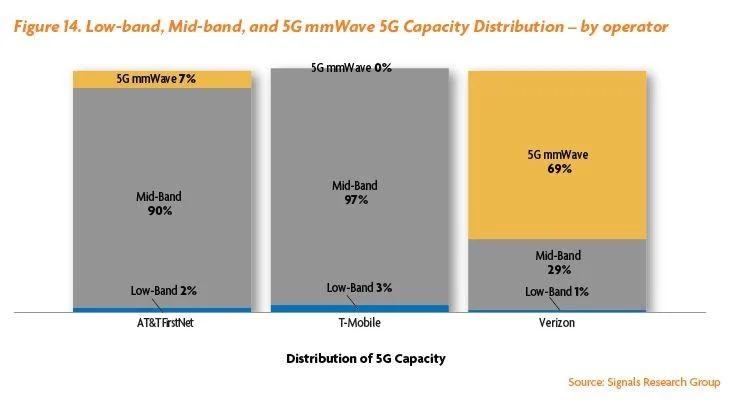Verizon is bringing a whole lot of millimeter wave (mmWave) spectrum to the big game this coming Sunday, while AT&T is leveraging mmWave, C-band and LTE. Of course, T-Mobile has its treasure trove of 2.5 GHz spectrum, making all three of the big wireless carriers locked and loaded with capacity.
Those are some of the take-aways from an analysis by Signals Research Group (SRG), whose founder Mike Thelander sacrificed time at his home in the arctic air of Minnesota to travel to Phoenix, Arizona, and conduct some drive tests around State Farm Stadium.
What he gathered is a lot of data about cellular capacity outside the stadium; it’s not intended to predict the types of service fans will experience when they’re at the Super Bowl. But it gives an idea of how this year’s Super Bowl is different from years past – and provides a reminder that this year’s T-Mobile ads will need to top last year’s Miley Cyrus and Dolly Parton singing the praises of 5G phones.
For all three operators, SRG estimates that 5G accounts for more than 75% of their potential network capacity, and “that’s a lot,” Thelander told Fierce.
On top of that, looking at LTE and 5G combined, somewhere between 70% and 80% of all the capacity will be on frequencies above 2 GHz, he said. All three have mid-band 5G, and T-Mobile also has LTE in 2.5 GHz.

SRG compiled these figures using scanner data and phone logs, but the figures don’t address how the capacity is distributed around the stadium. (Signals Research Group )
For AT&T (90%) and T-Mobile (97%), their mid-band 5G assets account for at least 90% of their total 5G capacity. For Verizon, the percentage was only 29%, and that’s because it uses so much mmWave, which represented 69% of available 5G capacity, according to SRG. The analyst firm also came across some AT&T mmWave sites. None of SRG’s analysis includes in-building mmWave assets; all of this analysis was done outside the stadium.
Thelander said he was surprised by how much CBRS spectrum Verizon is using in the area, which could be a combination of licensed and unlicensed. Either way, “they’re definitely leveraging it,” he said. It appears that about half of its LTE capacity available around the stadium is CBRS, or 3.5 GHz, he said.
SRG used a combination of a Rohde & Schwarz TSMA scanner and three Samsung Galaxy S22 smartphones to obtain information about LTE and 5G network deployments in the area around the stadium. Since the measurements were taken in mid-January, it doesn’t account for temporary equipment like cells on wheels (COWs) that operators bring in.
“How the traffic actually ends up getting distributed across those frequency bands” depends on the types of devices that are being used and how operators push their traffic, Thelander said.
3.45 GHz detected
Last week, AT&T said it wasn’t going to be using its 3.45 GHz licenses in the area of the Super Bowl, but Thelander said the super sensitive scanner detected 3.45 GHz when he was driving around the stadium. However, he said the signal easily could have been coming from sites not immediate to the stadium.
An AT&T spokesperson confirmed Tuesday that AT&T did not deploy 3.45 GHz in and around the stadium. However, it does have it in the greater Phoenix area, suggesting SRG may have picked up a signal from a macro site. The design for the stadium includes mmWave, C-band and LTE, the spokesperson reiterated.
Update: It’s worth noting that SRG’s log file shows its S22 phone on AT&T’s network used 3.45 GHz while driving around the stadium, so “it was definitely there, albeit perhaps not inside the stadium,” Thelander said.
Thelander also said he observed better device performance on 3.45 GHz than at 3.7 GHz, but that’s probably because it’s so new – there would be less interference at that frequency and therefore better performance. The Samsung S22 is one of the few phones with 3.45 GHz support and that’s thanks to a recent software upgrade, he said.
“Once the population of phones gets to be more evenly distributed, it’s going to be the same [performance] on both,” he said.
Verizon’s deployment of mmWave in stadiums across the country is well-known – as well as the knocks it’s received for investing so much in the technology – but the Super Bowl is a great stage to show it off, he said.
“This is a perfect scenario for millimeter wave. People are highly concentrated together, and they’re stationary,” Thelander said, noting that mmWave is ideal for providing a lot of capacity in concentrated areas. “How that actually plays out in terms of the distribution of traffic remains to be seen.”
Thelander isn’t making any predictions about the game, either, except that “someone with the last name of Kelce will get a new ring.”
Original article can be seen at:
